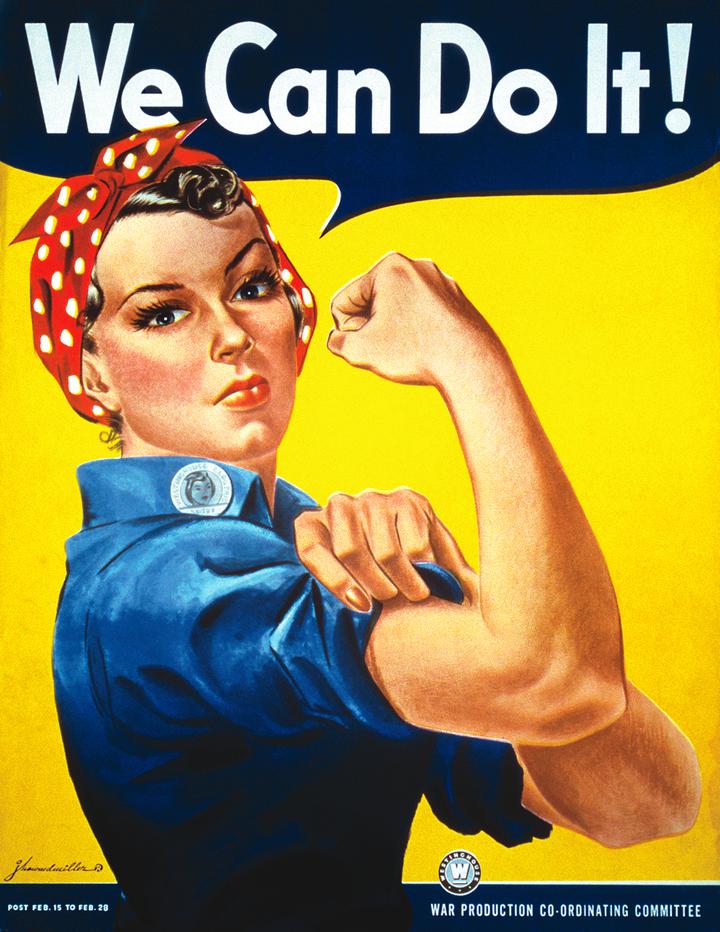Gender studies: an examination into the ways in which literature reproduces and subverts cultural norms surrounding gender roles.
Since we discussed Sleeping Beauty and the Airplane in class, alongside our discussion of gender and queer studies, I couldn’t stop thinking about what a strange story it was. It both objectified a woman and gave her agency that was nonexistent in the original fairy tale. In that vein, I became interested in media that both subvert and reassert gender norms.
In my search for a reflection of this phenomenon in contemporary media, I came across this 1940s advertisement.

The iconic image of Rosie the Riveter is the first thing you see. If you look closer, you may notice that she’s not the same Rosie shown below.

First, you might see her makeup looks a little more prominent than usual. Then, you’ll likely notice her wedding ring, or her painted fingernails. She’s a feminized Rosie.
Of course, you’ll notice the big blue letters: “Get the POWER.” Rise up, take charge, assume the place in the world you deserve that you’ve always been denied… as a cleaner. “The power to clean anything.”
This advertisement uses an iconic subversion of traditional gender roles to argue that women should be content in those traditional gender roles. The most prominent features of the ad are the instantly recognizable Rosie the Riveter figure and the statement “Get the POWER.” We associate these features on sight with the subversion of traditional gender roles for women as docile, domestic caretakers. It’s only once we have made this mental association that we notice the traditional expectations seeping through in the details. This display of unconventional and conventional side by side is an attempt to encourage women viewers to associate traditional feminine gender roles with empowerment and agency.
Examining this advertisement through a gender studies lens shows us that the “breaking” of traditional gender norms can ultimately serve as a tool to reinforce those same norms.

Great analysis! I loved the line “This advertisement uses an iconic subversion of traditional gender roles to argue that women should be content in those traditional gender roles”.
I thought it pointed out the message of this poster very well, as isn’t it quite startling seeing Rosie the Riveter feminized and selling domestic cleaning products? (or maybe not…)
I would have loved to see you expand more on your initial mention of Sleeping Beauty and the Airplane, as I agree with you that it was just so strange! Your idea of simultaneous objectification and agency was really interesting, and I think there is a lot of potential for further discussion there.
I must admit I never realized that there was more than one version of Rosie the Riveter! I love the analysis of the smaller details, such as the wedding ring and cleaning supplies. The ring is especially interesting to analyze because there is still pressure for women to get married. I would have loved to see more of a historical context applied in conjunction with gender studies because I am curious about over-feminization and beauty trends. In contemporary media, we have a clean aesthetic that fosters minimal makeup and a more glam full coverage style, but would that mean less makeup means you’re conforming less, or is that a question of the context?
I think the facial expression is also one of the important differences between the two ads. The top picture still reflects the traditional idea of a woman’s softness, while the eyes in the bottom picture appear more powerful and more in line with the image of a working woman.
A very good use of the lens of Gender Studies to examine an iconic image, and a piece of marketing material that drew on many of the tropes both invoked by the original Rosie the Riveter but also the tropes and traditions of society itself. Your analysis was well-reasoned and pointed to specific lines and details. I thought the strongest line was definitely “First, you might see her makeup looks a little more prominent than usual. Then, you’ll likely notice her wedding ring, or her painted fingernails. She’s a feminized Rosie.” Your voice is clear, and the meaning clearer.
One thing I think could help make the point more clear is trying to move around or shrink the two images a bit. As is, it’s a bit difficult to see both images at the same time to compare them to each other, requiring a decent amount of scrolling up and down between the two. Moving the blue box between the two images could help to resolve this fairly minor difficulty, or placing the images side-by-side.
The fact that you note the ring is great! That was a small detail that I did not originally notice. Rosie does look much more softened in this Clorox ad, especially in her facial expression. I think also the fact that the ad is for Clorox reasserts traditional gender roles, because its not an ad for women helping out in the war effort, but instead an ad for women helping out around the house, basically. I do agree with Adam that it would be helpful to make the images smaller and put them closer together so that they would be easier to compare/contrast.